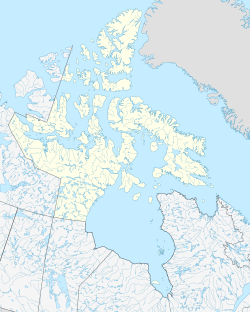Nuvuttiq (ᓄᕗᑦᑎᖅ[1]) formerly Cape Searle[2] is an uninhabited headland located on Qaqulluit's northeastern tip, in the Qikiqtaaluk Region of Nunavut, Canada.
Nuvuttiq
ᓄᕗᑦᑎᖅ (Inuktitut) Cape Searle | |
|---|---|
| Coordinates: 67°13′49″N 062°27′37″W / 67.23028°N 62.46028°W[1] | |
| Location | Qaqulluit, Nunavut |
| Offshore water bodies | Davis Strait |
| Native name | ᓄᕗᑦᑎᖅ (Inuktitut) |
| Area | |
| • Total | 2 km2 (0.77 sq mi) |
| Elevation | 450 m (1,480 ft) |
| Topo map | NTS 16M1 Block Island |
It was named by Arctic explorer John Ross on September 17, 1818 in honour of John Clark Searle, Esq.,[3] then Chairman of the Victualling Board.
Geography
editThe habitat is characterized by coastal cliffs and rocky marine shores. It is 2 km2 (0.77 sq mi) in size, with an elevation rising up to 450 m (1,480 ft) above sea level.
Fauna
editCape Searle is home to the largest northern fulmar colony in Canada.
Conservation
editIt is a Canadian Important Bird Area (#NU003), an International Biological Program site and a Key Terrestrial Bird Habitat site.[4]
References
edit- ^ a b "Nuvuttiq". Geographical Names Data Base. Natural Resources Canada. Retrieved May 21, 2024.
- ^ "Nuvuttiq (Formerly Cape Searle)". February 16, 2021. Retrieved May 21, 2024.
- ^ Ross, John (1819). A voyage of discovery. Vol. 2 (Digitized December 13, 2005 ed.). London: Longman, Hurst, Rees, Orme, and Brown. p. 31. Retrieved May 2, 2009.
- ^ "Cape Searle". bsc-eoc.org. Archived from the original on June 12, 2011. Retrieved April 23, 2009.
